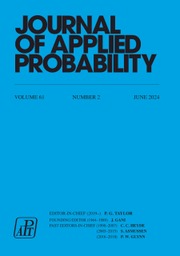Crossref Citations
This article has been cited by the following publications. This list is generated based on data provided by Crossref.
Itoh, Yoshiaki
Ueda, Sumie
and
Hasegawa, Masami
1980.
The broken-stick model for amino acid composition in proteins.
Journal of Molecular Evolution,
Vol. 16,
Issue. 1,
p.
69.
Itoh, Yoshiaki
1981.
Non-associative algebra and Lotka-Volterra equation with ternary interaction.
Nonlinear Analysis: Theory, Methods & Applications,
Vol. 5,
Issue. 1,
p.
53.
Itoh, Yoshiaki
1984.
Random collision model for random genetic drift and stochastic difference equation.
Annals of the Institute of Statistical Mathematics,
Vol. 36,
Issue. 2,
p.
353.
Itoh, Y.
1987.
Integrals of a Lotka-Volterra System of Odd Number of Variables.
Progress of Theoretical Physics,
Vol. 78,
Issue. 3,
p.
507.
Itoh, Y.
1988.
Integrals of a Lotka-Volterra System of Infinite Species.
Progress of Theoretical Physics,
Vol. 80,
Issue. 5,
p.
749.
Itoh, Yoshiaki
1989.
A certain configuration of random points on a circle associated with a generalized Lotka-Volterra equation.
Journal of Applied Probability,
Vol. 26,
Issue. 04,
p.
898.
Tainaka, K
and
Itoh, Y
1991.
Topological Phase Transition in Biological Ecosystems.
Europhysics Letters (EPL),
Vol. 15,
Issue. 4,
p.
399.
Itoh, Yoshiaki
1993.
Stochastic Model of an Integrable Nonlinear System.
Journal of the Physical Society of Japan,
Vol. 62,
Issue. 6,
p.
1826.
Itoh, Yoshiaki
and
Tainaka, Kei-ichi
1994.
Stochastic limit cycle with power-law spectrum.
Physics Letters A,
Vol. 189,
Issue. 1-2,
p.
37.
Tainaka, Kei-ichi
and
Itoh, Yoshiaki
1994.
Glass effect in a prescribed marriage system.
Physics Letters A,
Vol. 187,
Issue. 1,
p.
49.
Tainaka, Kei-ichi
1994.
Vortices and strings in a model ecosystem.
Physical Review E,
Vol. 50,
Issue. 5,
p.
3401.
Tainaka, Kei-ichi
1995.
Indirect effect in cyclic voter models.
Physics Letters A,
Vol. 207,
Issue. 1-2,
p.
53.
Tainaka, Kei-ichi
and
Itoh, Yoshiaki
1996.
Apparent self-organized criticality.
Physics Letters A,
Vol. 220,
Issue. 1-3,
p.
58.
Itoh, Yoshiaki
Mallows, Colin
and
Shepp, Larry
1998.
Explicit sufficient invariants for an interacting particle system.
Journal of Applied Probability,
Vol. 35,
Issue. 03,
p.
633.
Itoh, Yoshiaki
Maehara, Hiroshi
and
Tokushige, Norihide
2000.
Oriented graphs generated by random points on a circle.
Journal of Applied Probability,
Vol. 37,
Issue. 2,
p.
534.
Tainaka, Kei-ichi
and
Nakagiri, Nariyuki
2000.
Segregation in an interacting particle system.
Physics Letters A,
Vol. 271,
Issue. 1-2,
p.
92.
Gouet, Raúl
and
López, F. Javier
2001.
Saturation in a Makovian Parking Process.
The Annals of Applied Probability,
Vol. 11,
Issue. 4,
Sato, Kazunori
Yoshida, Naoto
and
Konno, Norio
2002.
Parity law for population dynamics of N-species with cyclic advantage competitions.
Applied Mathematics and Computation,
Vol. 126,
Issue. 2-3,
p.
255.
Itoh, Yoshiaki
Mahmoud, Hosam M.
and
Takahashi, Daisuke
2004.
A stochastic model for solitons.
Random Structures & Algorithms,
Vol. 24,
Issue. 1,
p.
51.
Sato, Yuzuru
Akiyama, Eizo
and
Crutchfield, James P.
2005.
Stability and diversity in collective adaptation.
Physica D: Nonlinear Phenomena,
Vol. 210,
Issue. 1-2,
p.
21.

